If you’re dealing with silverfish in your home you probably already know the amount of damage they can cause. Silverfish are known to be a destructive best, and for many homeowners, the last draw is when they destroy precious possessions, including clothing, books, papers, and wallpaper. The good news is, in the rest of this article, I’m going to show you how to get rid of silverfish for good!
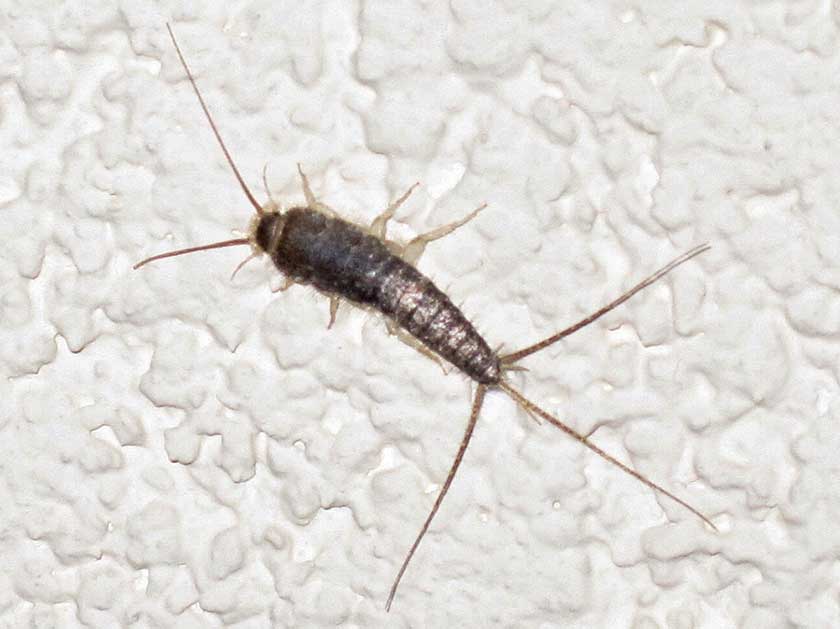
Below, I’ve listed my favorite silverfish control products as well as some proven natural remedies. If you have any questions about how to use them effectively after reading this guide, don’t hesitate to ask me in the comments.
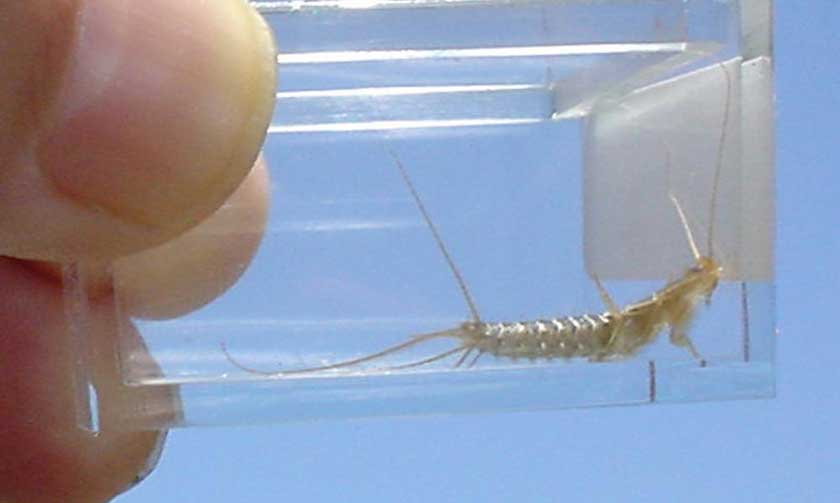
Silverfish consume carbohydrates and can feed on shampoo, linen and silk, and have even been found in unopened food packages. They are small and wingless, often compared to earwigs and firebrats. As their name suggests, silverfish are typically silver in color, other than when they are first hatched, when they are closer to white. Their bodies are also tapered in a way that looks sort of like a fish, and they wiggle when they move in a fishlike manner.
Cluttered, damp, or warm environments are usually the catalysts for a silverfish infestation. The bugs are often found in areas such as basements and kitchens, where they can feed off of other insects and stay away from humans. They also love to snack on food particles, which is why they are attracted to kitchens and can get into dry goods like cereal, flour, pet food, pasta, or rice. Cracks or holes leading into these spaces provide an easy entrance for silverfish to crawl in.
Here are the Best Ways to Get Rid of Silverfish
1. Dekko Silverfish Traps
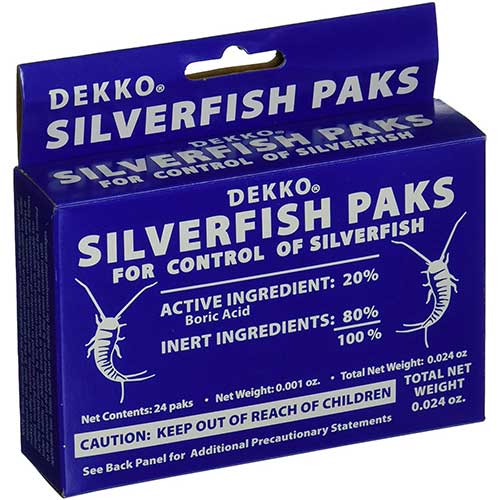
Dekko Silverfish Paks are paper envelopes that contain boric acid, which is poisonous for silverfish. The paks look similar to the small cracks that silverfish are attracted to, and the boric acid is mixed into a glue that the bugs like to feed on. This option is simple – one or two paks can be placed in the environment that the silverfish are in, such as under the sink or every few feet in a basement. They can also work preventatively, as long as they are replaced every three months.
Note: Traps like these are not typically an immediate solution for a large silverfish infestation. It may take a few weeks before an infestation really starts to get under control. They are much more useful in some cases than in others. You may want to use traps along with some of the other treatment methods (like the powder listed below) as more of a comprehensive approach to get rid of silverfish. Luckily most of these products are cheap and still much less expensive than calling in a professional. If do it yourself solutions fail, we do recommend calling an exterminator.
Even after you solved your silverfish problem, you may want to keep a few traps out as a preventive measure.
| Pros | Cons |
| Can be used preventatively | Takes time before all silverfish are killed |
| Work for up to three months | |
| No odor and no residue |
2. Trapper Max Mouse and Insect Glue Boards
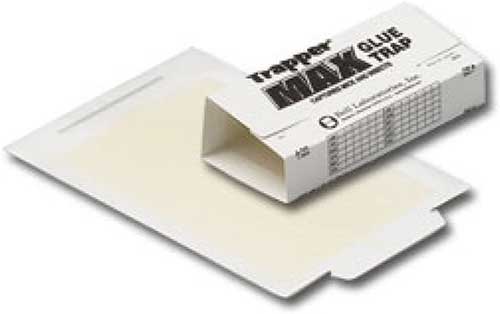
Trapper Max Glue Boards are perhaps one of the simplest pest traps to use. The boards are flat and have a sticky glue on one side, which is covered by a protective layer that is peeled off when ready to use, and trap any pest that walks across. They can also be folded into an open-ended box to protect the glue. One of the biggest benefits of using a glue board as a trap is that they do not contain any type of poison, and are safe to use around food and animals or in areas that prohibit poisonous insecticides. The original Trapper Max boards are peanut butter-scented to attract pests, but an unscented version is also available (Trapper Max FREE).
These traps are effective for many types of pests, and in your attempt to trap silverfish you will likely find other types of pest trapped as well. We have heard stories of people catching all kinds of pests including scorpions, spiders, and even mice. Some users also report issues with bugs they didn’t even know about before using these traps. For the money, these traps a great value considering how effective they are and the number of traps in each pack.
| Pros | Cons |
| Can be used for many types of pests | Must be disposed of after one use |
| Do not contain poison | |
| Can be left flat or folded into a box |
3. Terro T3206 Spider & Insect Trap
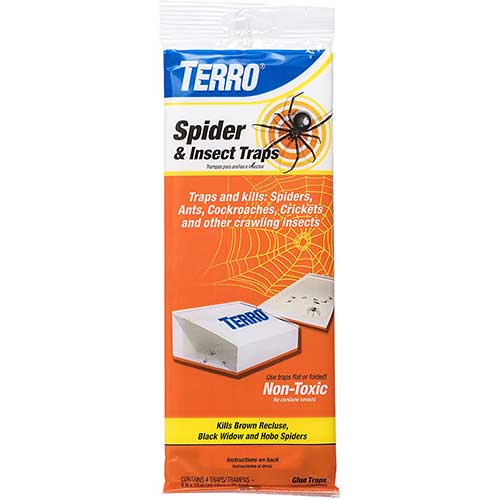
The Terro T3206 Spider and Insect Trap is used in a very similar manner to the Trapper Max glue boards. Each trap is flat with a sticky side, and can be folded into a tent-like shape to cover the glue. These traps are also insecticide-free and are safe to use in areas where poison should not be used. Compared to the Trapper Max boards, the Terro Spider & Insect Traps may not be suited for catching mice or rats, but users may choose to leave them out for a longer period of time if there is no dead rodent to dispose of. The traps can be used either on their own or with insect bait.
| Pros | Cons |
| Can be used for many types of crawling insect | More expensive than Trapper Max traps |
| Do not contain poison | Must be disposed of after one use |
| Can be left flat or folded into a tent |
4. Harris Famous Roach and Silverfish Killer Powder
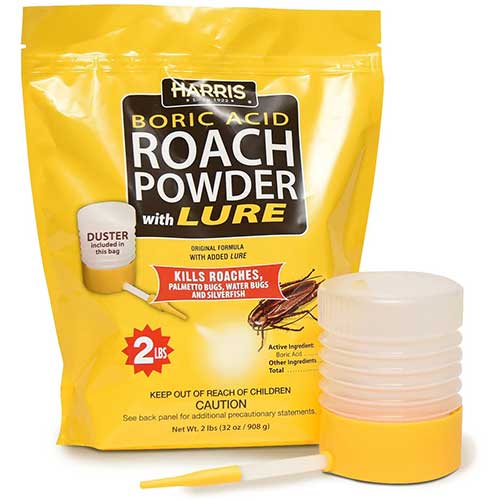
Harris Famous Roach and Silverfish Killer Powder take insecticides a step further by including a food-grade lure that will draw silverfish in. Insect powders are one of the most popular forms of insecticides. A duster can be bought along with the powder to make distribution easy, or the powder can be purchased as a tablet to reduce any mess. The powder kills any insects that come into contact within 72 hours, getting rid of silverfish, roaches, palmetto bugs and water bugs. It will also work for weeks after the initial application, as long as it stays dry. Caution needs to be taken when using around children or pets – the product claims to be safe to use, but ingestion can be dangerous.
We find this powder to be extremely effective for silverfish and roaches. We often recommend a powder to be used in combination with glue traps.
| Pros | Cons |
| Inexpensive | Contains poison |
| Comes with applicator or in tablet form | Powder may be messy |
| Dead insects aren’t contained in one area |
5. Wondercide Natural Indoor Pest Control Spray
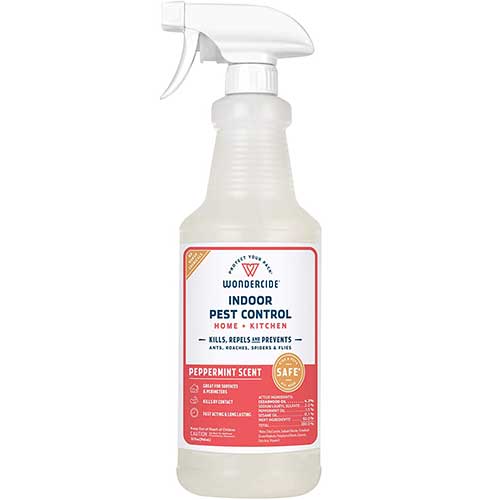
Wondercide Natural Indoor Pest Control is a sprayable option that is made with essential oils, allowing customers to choose between peppermint, cedar, rosemary, or lemongrass scents. Wondercide spray kills multiple types of insects, including silverfish, without the use of toxic chemicals. While attempting to gain control of a problem, homeowners should spray the pest control every 2-3 days until there are no signs of silverfish, then, they can reduce the frequency. For prevention, Wondercide can be sprayed every four weeks.
The pleasant scent of the Wondercide Natural Indoor Pest Control is regarded as one of its best aspects, but we also love how effective it is. In addition, people with pets or children are big fans of the fact that the spray does not contain toxic chemicals. The scent is helpful for knowing how often to spray the pest control – once it starts to wear off, it should be sprayed again – but those with a sensitivity to fragrance should take precautions.
| Pros | Cons |
| Safe to use around food, pets and kids | Pricier than other pest control options |
| Smells great | Needs to be sprayed every 2-3 days |
| Works preventatively |
Home Remedies for Silverfish Control
One of the biggest downsides to store-bought pest control is that you have to choose between killing the insects with poison or trapping them, where you would then have to handle live insects to remove them from your house. However, you could have the solution to all of your silverfish problems already in your pantry. To avoid having to use traps or potentially dangerous chemicals to get rid of silverfish, look to natural remedies to repelling insects.
6. Diatomaceous earth

Diatomaceous earth is possibly the most popular silverfish repellent available. It is made from the skeletons of diatoms, which are small aquatic organisms, and contain silica. Diatomaceous earth has been used as a pest control product for about 80 years. It’s typically viewed as one of the more natural solutions to pest control – when insects come into contact with the powder, it will attach to their exoskeletons and suck out any moisture, dehydrating and killing the bug. It can be sprinkled in low-traffic areas, particularly in any potential silverfish breeding grounds, and will continue to work as long as it is kept dry.
One of the primary reasons that diatomaceous earth is such a popular pesticide product is that it is non-toxic and safe to use around children, pets, and people with compromised health. Despite that, homeowners should watch out for any contact with the powder. If inhaled, it can cause coughing, shortness of breath or irritated nasal passages. If it is touched, diatomaceous earth can irritate skin or eyes. Distributing the powder in low-traffic spaces where it is mostly kept away from children and pets is the best way to avoid any potential harm. Another downside to using diatomaceous earth is that it is slower to kill insects that poisons could be, but if ridding your house of silverfish isn’t urgent or if you have people or animals in your house that could easily come into contact with the poison, the non-toxic route may be the safest option.
Related Article: 7 Best Ways to Get Rid of Fire Ants
7. Essential oils (See Recommended Oils)
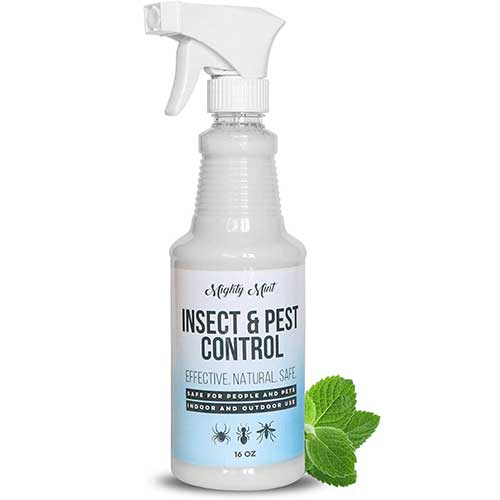
Essential oils have been growing in popularity in recent years and are known particularly for having a wide range of uses. One of those many uses is as a bug repellent. Depending on how they kill insects, essential oils can either be mixed into a spray and applied directly to the bugs (if they are killed from the oil itself) or sprayed in and around an area that could potentially attract bugs (if they are killed by the scent of the oil). Many oils can be used as an insect repellent because of their strong scent, but peppermint, orange, lavender, cinnamon, clove, and cedar all stand out as great silverfish deterrents. Most of the oils do not actually kill silverfish, and therefore wouldn’t be as effective in getting rid of an infestation as they would be in avoiding bringing the bugs into your house.
Different scents can be combined to kill a wider range of bugs or to make a single solution more effective. Oils should be diluted with water, soap, or vinegar in order to use them as a spray if only to be sure the scent isn’t too strong for humans and pets. Exact recipes for essential oil sprays vary depending on how they will be used. Besides creating a spray, soaking cotton balls or fabric scraps with essential oils can create a makeshift diffuser. Sachets can be placed in areas where other insecticides could be too dangerous, like in a kitchen, hospital or around the beloved possessions that silverfish are attracted to, like books and clothing.
Orange oil
Orange oil is typically seen as one of the best natural insecticides as it contains d-limonene, which is not toxic for people but can erode the coating on a bug’s exoskeleton, thereby causing them to dry out and suffocate. In addition to orange oil, the scent of peppermint oil or tea tree oil can act as a powerful deterrent for silverfish.
Lavender oil
Lavender oil is another popular option for a natural insect repellent. A teaspoon of lavender oil can be diluted with around one-quarter to one-half cup of water, poured into a spray bottle and sprayed into a closet, over a bookshelf or into the carpet. In addition, wiping the mixture onto the walls of your house will create an extra barrier, and add a relaxing scent to every room.
8. Natural Spices (See Recommended Spices)
Cinnamon, clove, and cedar essential oils can all be used to ward off silverfish, but so can the natural spices. Ground cinnamon can be made into a sachet, but whole sticks are more effective. They can be placed into the areas where silverfish would be attracted, such as under a kitchen or bathroom sink, in bookshelves or in a basement. The same can be done for whole cloves. Bookshelves or chests made of cedar can have a built-in silverfish repellent, as the scent of cedar is toxic to the bugs. However, if your shelves and chests are not made of cedar, or if you’d like to use the wood as a repellent in a different area, such as in your closet, cedar panels or balls can be purchased to add wherever you need them. You could also use cedar chips as mulch around your house to create a preventative barrier.
You could have another silverfish repellent already in your closet. Mothballs are known to be repulsive to silverfish, as well as a host of other pests, such as fleas or snakes. Nevertheless, using mothballs as pest control can come with other problems. They can be poisonous if ingested, so homes with children or pests should be particularly careful when choosing this insecticide option. They can also give off fumes that are toxic when inhaled; mothballs that are made in America contain either naphthalene or paradichlorobenzene, which can both lead to bad side effects, and even kidney or liver damage if inhaled continuously for a long period of time.
Related Article: House Centipede vs Silverfish
9. Mothballs as a Repellent
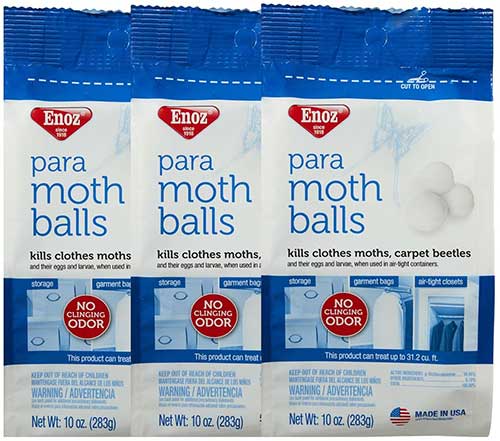
Many people use mothballs as pest repellents outside of their house, usually in a garden. Because they are not in an enclosed space, they do not pose the same problems with inhalation as they would if they were used inside the house. They can, though, still harm any animals that eat them. In addition, the naphthalene and paradichlorobenzene used in mothballs can end up seeping into soil or groundwater, contaminating them and possibly even hurting the plants that they are trying to guard from predators.
10. Hiring a professional pest control technician
When all else fails, a professional exterminator may be the best option for ridding your house of silverfish. Of course, at-home methods may be cheaper and not as time-consuming as hiring a professional, but you may decide that chemicals, glue traps, and fragrant solutions will not work best for your household. Or you may have tried all of the above options and still see silverfish scurrying across your floor. Exterminators can get rid of the problem, as well as issues with other pests, on top of inspecting your house to determine if there is an infestation in the first place. They can make sure that the members of your family will not be harmed in the process, and they can prevent pests from invading your house in the future.
Preventing a Silverfish Infestation
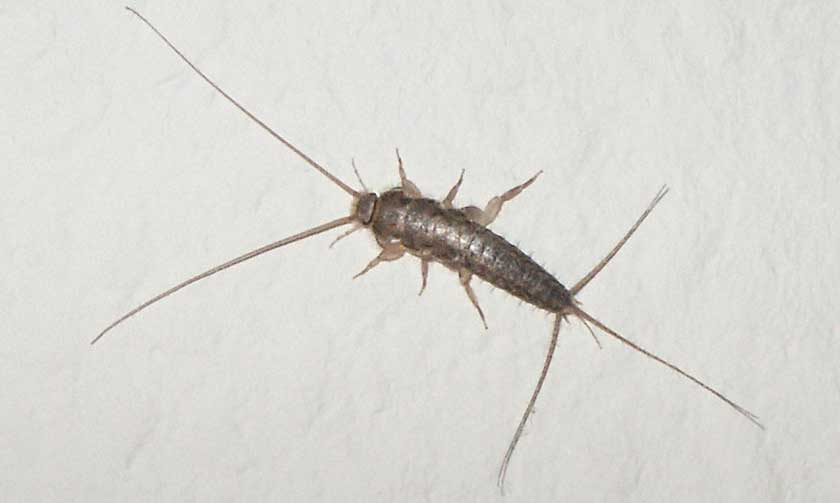
What’s the best way to get silverfish out of your house? Don’t let them get in in the first place. Prevention is fairly easy and often uses the same products that you would use to get rid of silverfish or other insects. The best way to begin preventing silverfish is to understand what it is that attracts them.
Silverfish may be able to get into your house if you bring in cardboard or plastic boxes that have been kept in a place that has already been infested. One of the simplest ways to prevent this is by keeping track of the containers you bring into your home. Do you know where that box had been stored before you picked it up? If it’s questionable, you may want to look over the contents and the box itself to be sure there are no silverfish or silverfish eggs hiding out.
You could have silverfish eggs somewhere in your house without knowing that they’re there. In fact, you may have even seen them and not known what they are. Once the eggs hatch, you might have to deal with an infestation; it’s important to be able to recognize eggs to ensure this doesn’t happen. Silverfish can lay many eggs every single day – up to 20 eggs in a bunch, two or three times a day. The eggs are oblong, similar to the shape of a bird’s egg, and are soft and white when first laid, changing to be hard and yellow within a few hours.
Silverfish Appearance
In addition to knowing what the eggs look like, you must also know where to look for them. Because silverfish are attracted to tight spaces, their eggs will also be located in the tightest corners of your house. They could end up being covered in dust or other particles, hiding them from plain sight in areas like a basement, kitchen or even in your clothing drawers. To make matters worse, once the silverfish lay their eggs in a suitable area, they will give off pheromones to other silverfish to alert them to their location, bringing more bugs into the same place.
You could also prevent silverfish by making sure there are no attractive environments for them to flock to. Because they so often enter your home through whatever cracks and crevices they can find, you may choose to seal up any possible entrances. It’s important to examine your house with a keen eye to find any open cracks where bugs or other pests could climb through. Door closers, weather strips or caulk can seal your windows and doors. You may also choose to place screens over your windows if you like to open them. Be sure to check any pipes leading into your home for excess space around the opening where bugs could crawl in.
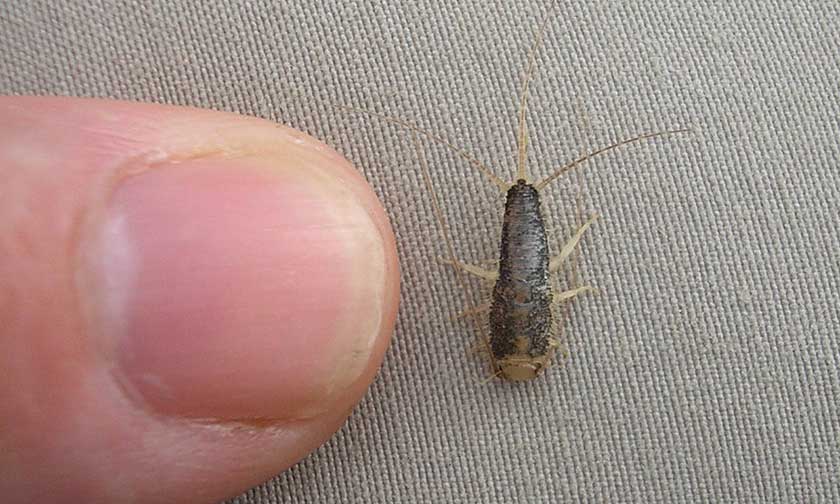
Silverfish Prefered Environment
Silverfish love moist atmospheres, so you want to dry out any dampness that could attract them. Outside of your house, look for piles of leaves or any other wet refuse to avoid drawing silverfish closer to where you live. Inside, try adding dehumidifiers to your bathroom, basement, or any other rooms where moisture and humidity is common. Fans could also clear out humid air, especially in the bathroom where showers could create the ideal environment for silverfish. If you have a leak in your basement or bathroom where water can seep in, use caulk or hydraulic cement to patch them up and keep your house dry.
As dry goods are so appealing to silverfish, all food, particularly carbohydrates and starches, should be carefully stored, with extra care being taken to make sure they are correctly sealed and not accessible to tiny bugs. Clear dirty dishes as soon as possible – don’t leave them lying around long enough for insects to find them – and clean up any other food waste to avoid creating a buffet for silverfish. Sweeping and vacuuming floors regularly can keep your house clear of much of the debris that silverfish love.
Prevening Silverfish Infestation Early
Oftentimes, the products that are used to rid your house of a silverfish infestation can also be used to prevent them from ever coming in in the first place. You may choose to place traps or sprinkle the insect-killing powder in low-traffic areas to capture and kill any possible invaders. If you have children, pets, or health-compromised people in your home (or wherever you are trying to prevent silverfish invasions), be sure to understand what products you are buying and if they could present any health risks to the members of your household.
But sometimes it’s too late to take preventative measures – what happens when they’ve already crept into your house? Silverfish traps and powders are simple to use and often inexpensive.
One easy way to start narrowing down the many options of pest control is to decide if a non-toxic solution is needed, or if one with insect poison would be more convenient. Many insecticides use boric acid, which kills bugs but is harmful to humans and animals. When using around food, such as in a kitchen, around children, or in a hospital, a non-toxic alternative may be much safer. Glue traps don’t contain harmful toxins, and other pest controls (like the Wondercide Pest Control featured on the following list) do not use chemicals to kill pests.
Silverfish traps and killers can often be found at big-box stores, home improvement centers, or online at websites like Amazon.
Frequently asked questions (FAQ)
Silverfish aren’t an obscure pest – a simple search engine query can give you a long list of facts about the bugs or how to get rid of them. Many people have their own thoughts on how to best get rid of or prevent silverfish, but when looking for an effective insecticide or repellent, it’s important to know what information is correct and what is not. Certain solutions may not work for everyone, and you should know how severe your bug problem is, what to expect from the bugs and what the best way to get them out of your own house is before looking for a resolution.
Are silverfish harmful?
Despite the havoc that they can wreak on your belongings, silverfish are not harmful to humans; they don’t bite, aren’t venomous, and don’t carry diseases. They aren’t able to fly or run quickly on surfaces that aren’t horizontal. However, that doesn’t mean that they are welcome in your home. The things that attract silverfish can also bring in other insects, making your home a breeding ground for pests. Educating yourself on what silverfish are enticed by and how to avoid an infestation will help to keep your home clean, safe, and free from all kinds of bugs.
Can silverfish hurt me, my family, or my pets?
While their bite marks can end up destroying some of your most favorite possessions, silverfish do not actually bite humans or other animals. In addition, they do not carry diseases or pathogens that could contaminate your food, and they do not sting. The primary reason for wanting them out of your home is to protect your personal items and, of course, avoid having creepy crawlies sleeping under the same roof that you do.
Can silverfish swim?
The name “silverfish” makes many people think that these creatures are, in fact, fish. But silverfish are not able to swim; they get their name for their tapered bodies and their swim-like movements when they walk. They are attracted to moist environments, but if they’re submerged in too much water, silverfish can actually drown. Furthermore, silverfish cannot fly and have a hard time crawling on non-horizontal surfaces, like on walls. They can only really be found on mostly dry, flat surfaces.
Are silverfish really silver?
Again, the name can be misleading to someone who has never seen one. Silverfish are often silver in color but can be brown as well, and when they are first hatched, they are closer to a milky white. As they grow older, their exoskeleton will begin to darken. Moreover, silverfish eggs start off as white and turn yellow over time. When examining your house to look for a potential infestation, it’s important to know that you won’t necessarily be looking for silver bugs.
Will silverfish prey on the other insects in my house?
Silverfish are fairly small insects – around ¾ of an inch in length – and don’t really prey on any other bugs. In reality, they are usually preyed upon by spiders, earwigs and house centipedes. In other words, it’s not the best idea to purchase creatures to eat the silverfish that are infesting your house, unless you want to end up with another bug problem. Unfortunately, silverfish can bring other insects into your house with them, only adding to the infestation instead of preying on pests.
Where do silverfish come from?
Most people only notice silverfish when they’re already inside the house. Inside, they are usually found in basements, kitchens, bathrooms, or other humid areas, but they have to come in from somewhere else. In nature, silverfish can be found just about anywhere. Often, they live under tree bark or rocks, in rotten wood or hidden in piles of leaves, especially if the leaves are wet. Some species can be found in caves or in ant or termite colonies. Silverfish can be found all over the world, although they prefer warm and humid environments and are thought to be native to Europe, northern Asia, and northern Africa.
Can silverfish lay eggs in my ears?
It may seem like a silly question, but silverfish are often compared to earwigs, which are also rumored to lay eggs in humans’ ears while they are sleeping. They are then said to make their way into the victim’s brain. Fortunately, this is no more than a rumor for either insect. While it is possible for silverfish to lay eggs in human ears (but certainly not likely), they are much more apt to lay their eggs in the same cracks and crevices that they are attracted to. Even in the rare recorded cases where insects have laid eggs in sleeping victims’ ears, there has never been a case of them making their way to the brain. The only harm that you should be concerned about is the damage that silverfish can cause to your belongings.
How are silverfish different from earwigs or firebrats?
Silverfish and earwigs have similarities other than not laying eggs in ears. In biological classification, both insects fall into the same class, but different orders. Silverfish have soft exoskeletons, with three soft limbs connected to their abdomens. Earwigs have hard exoskeletons with two hard forceps on their abdomens. Earwigs are able to pinch with their forceps and some have wings that give them the ability to fly; silverfish are harmless and cannot fly. They also have different food sources – earwigs tend to prefer feeding on plants, either living or decaying, while silverfish are attracted to carbohydrates, like the dry goods you have in your kitchen, and paper products.
Other than earwigs, silverfish are also compared frequently to firebrats, which are small, wingless insects that are even more similar to the silverfish than the earwig is. Firebrats feed on the same things that silverfish do and can end up destroying books, wallpaper, or clothing. Both bugs usually only come out at night. However, firebrats are slightly smaller in size and have less of the tapered fish-shape that silverfish are named after. Firebrats also prefer their climates to be warmer than the temperate weather that silverfish like to live in. This means that they can often be found in boiler rooms, near warm kitchen appliances (like an oven), and around hot water pipes.
How do I know if I have a silverfish infestation?
Often the easiest way to know if silverfish have invaded your house is to see them scurrying around. Keeping an eye on the rooms in your house that would be most attractive to them will help you to know if you have an infestation. Because they are nocturnal, you may only see them if you venture into your basement or kitchen at night, but you could also see them in damp areas such as the space below your sinks or in your bathroom.
If you inspect these areas and see tiny white or yellow oblong eggs, you may have found a nesting location for silverfish. The eggs will be found in the same location that the silverfish would be, but are more likely to be stored in cracks and crevices nearby, so be sure to look for any potential nests while you are inspecting. You may also be able to see silverfish feces, which is often compared to pepper because of its size and color.
A worse case silverfish infestation
In the worst case, you could see the damage that silverfish can inflict on your books, clothes or wallpaper after it’s done. If you find holes in any of these items, you could potentially have a silverfish infestation. Obviously, the damage cannot be undone, but you can protect your treasured possessions by taking preventative measures to ward silverfish off.
If you do find out that you have silverfish in your home, it’s good to know that infestations are never permanent – there is a multitude of products and solutions that you can use to get the bugs out of your house and away from your possessions. Boric acid can kill the bugs fairly quickly, but essential oils, citrus sprays, and cucumbers are all said to repel silverfish in a more natural and non-toxic way.
You can even make your own traps: wrapping wet newspaper in dry newspaper creates an attractive food source for silverfish, and a mason jar wrapped in masking tape with food inside will also trap the bugs without a way to climb up the slick glass interior. Although they are one of the more common household pests, you don’t have to be another victim of a silverfish infestation. Take action as soon as possible after noticing the bugs, and you can rid your house of silverfish in no time.
Related Article: Best Ant Killer Products
My name is Blane and I’m a life-long resident of Southeastern Louisiana. I’ve been working as Pest Control Technician and Inspector for about 1.5 years now.
I’ve worked in many other industries as well, including consulting, managing, as well as at the ground level in fields including Food Service, Corporate Automotive sales, and finance. Whether it be providing counsel, content, or hands-on support; my goal remains to add value to the lives of the people I serve.
If you have any questions regarding pest control, leave them below. I would be happy to help you out in any way I can.

Hello, Mr. Spiller,
I moved into a rental townhouse about 8 months ago. I have been fighting centipedes for a while. I noticed a few silverfish coming out now. I have been using peppermint, lavender, and lemon oils to kill them naturally without the harsh chemicals. I also have ultrasonic pest control in a few rooms to keep them away. Even an exterminator came out to spray in September as well. I have asked the landlord how long the townhouse was vacant, no answer. I’m so tired and ready to move.